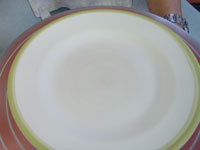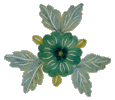
Manufacturing Ceramics:
Step by Step Production Process
Every piece of ceramics we produce is entirely hand made from beginning to end. The clay is taken from the banks of the River Arno, which runs through Florence and our potters, whose work shop is just outside the city, make the wonderful shapes. Either the potter throws the piece on a classic wheel or it is hand molded into a cast to give a more regular shape. The clay is then set aside to dry before being fired in the kiln for the first time. The result of that first firing is the terracotta form that our glazers and painters then work on. This terracotta form is also called a bisque, bisquit, or biscotto.
We use two different types of clay: the first is a traditional type of clay, exactly like the one used by potters in Italy in the 15th century. It is formed through fluvial sedimentation of soil over millions of years. During processing it is grey green in colour and after firing it shows the typical Tuscan brick red. The finished shapes are usually called ‘biscotto’ (from ‘bis’ = two, twice, and ‘cotto’ = cooked; biscuit or bisque) as they are first ‘cooked’ in the sun and then the second time in fire. This clay is used to produce the traditional plates on a potter’s wheel, vases, jugs, cups and all other objects of a rounded shape. It can also be used to produce special shapes in plaster moulds like - for example – oval trays, which cannot be made on a wheel.
Another type of clay we use is comparatively more refined and modern and comes closer to white porcelain in colour and specific weight. This material is used in liquid form to create products by pouring the ‘slip’ into plaster moulds. Basically this is the same technique as used when creating bronze statues by pouring molten metal into a negative shape of the object to be created, but using cold materials.
After the firing in the kiln we have a terracotta form. The next stage of the process is glazing. Each piece is dipped into liquid glaze, which we prepare ourselves, and when entirely coated in the glaze it is left to dry for a day or two.
Then the most time consuming part begins. Each piece is individually hand painted, allowing the personal style of each painter to appear.
The paints are made from natural minerals and by mixing them in our own studio we are able to obtain a broad range of tonalities, which distinguishes our work from other ceramics.


 |
The powder colour is mixed with water and then applied to the glazed surface of each piece. The most remarkable thing to notice at this stage is the flat, opaque nature of the colour before firing, and each painter must be aware of how these colours will change during firing to ensure that the correct tonality is achieved in the end.


 |
The final stage of the production is the second firing. This transforms not only the colours, but also the glaze, which becomes a solid shiny surface that will survive well for many years. The gas fired kiln reaches a temperature of 940°-950° C (about 1700° F) in a twenty-four hour cycle, twelve hours to reach the maximum temperature and twelve hours to completely cool. Only then can we open the kiln and discover the results of so much patient work.
![]() For further information and to order contact@rampiniceramics.com.
For further information and to order contact@rampiniceramics.com.
Due to the characteristics of monitors the colours in images may vary from the original ceramics pieces.
Copyright © 2009 Rampini Ceramics (all text and images).
